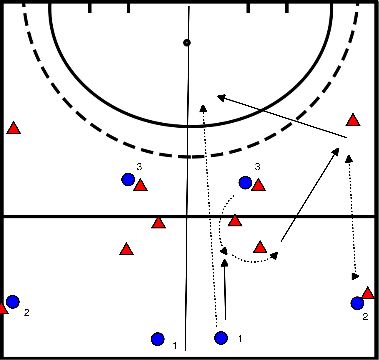Hockey drills for technique 1,5 meter / corona / covid-19
- Position the pawns as shown in the figure
- Spread the balls on pylons C and D.
- In this exercise you place a player on the pylons C and D.
- The rest of the team lines up at the A-post.
- From A the player walks around the pylon
- From the pylon, the player makes a sideways movement, facing the ball (facing C)
- Player C plays the ball into the forehand of A
- A takes the ball and turns to the right to open
- A runs towards the circle and finishes on goal.
- From here he runs to D and receives another ball.
- The player turns open to the left and again finishes on goal.
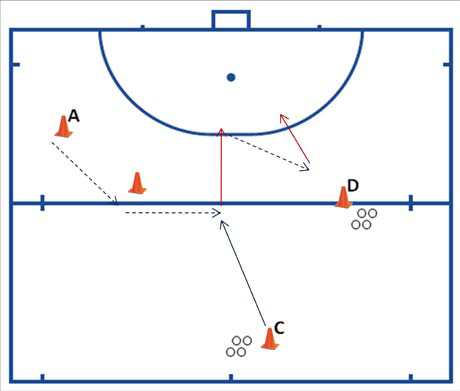

Goal: Improve passing. To improve finishing on goal.
Organisation: Half playing field 2 attackers (Z) â€" 1 goalkeeper Course with 1,2-ties, dribbling and finishing on goal. After each pass you have to run to get the ball back from the attacker.
Tip: Before shooting on goal, pay attention to the position of the goalkeeper!
Variations: Practise different passing moves, both anti-clockwise and clockwise.
The exercises can be played in 2 variants the variant for really beginning hockey players (this exercise can be used for a clinic for example) and the variant intended for beginning hockey players who have already been in touch with hockey.
Variation 1:
- Player 1 plays the ball to player 2,
- Player 2 receives the ball and passes to player 3.
- Player 3 receives the ball and shoots at goal.
- Player 4 tries to stop the ball with the bottom of his foot or with his stick.
- Player 4 retrieves the ball and joins the back of the line at the starting pawn of player 1.
- For safety's sake don't shoot on target when player 4 picks up the ball.
- It is also possible to get the balls out of the goal later or use a break for that.
- This is for safety reasons.
- Player 1 plays ball on player 2.
- player a runs on and receives the ball back, player 1 now plays ball on player 3 and receives the ball back again and shoots the ball at goal.
- variation:
- instead of shot on goal,
- gives player 1 a pass for the goal on player 4
- player 1 takes the place of player 4.
- player 2 and 3 remain.
- This is a basic exercise in preparation.
- Just like a tennis player who prepares for training with basic strokes, the players must prepare for the complex training and competition forms, with direct simple passes on top of each other.
- In this way, the trainer has the ability to see technical errors in each individual player and correct them as early as the basic exercise.
- The players pass the ball directly between two pylons and walk counter-clockwise to the other side.
- The size of the target and the distance between the players will be adjusted according to the age and level of the players.
- 1A person on the 23 meters,
- 1B on the back line.
- Both on the left side of the field.
- A scoops to B and runs to head circle.
- B runs to circle edge and plays on A.
- A finishes on goal.
- Blue player receives the ball from the white player each time. (white player distributed)
- Red player runs from stroke point to head circle and receives ball from blue player.
- Red player shoots on goal.
- After each shot he walks back to stroke point and then receives the next ball from head circle.
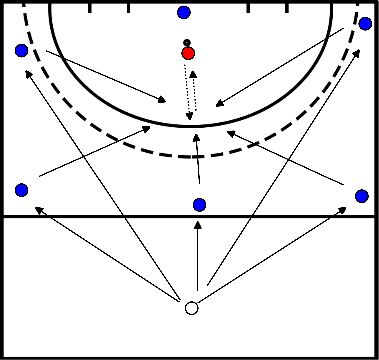
- Jump where you stand:
- Stand with your feet shoulder-width apart.
- Concentrate on a point on the floor and hop up and down where you stand.
- Jump sideways:
- Stand up straight, keep your hands in front of you and jump from side to side.
- Butt Kicks:
- Stand up straight, and keep running in your place as you lift your heel up and touch your buttocks with every step.
- High stepping:
- Lift the leg with the knee at a 90 degree angle.
- Quickly alternate with the other leg.
- Standing bike crunches:
- Stand with your feet apart at shoulder width.
- Bring your knee to your opposite elbow.
- Go back to the starting position and repeat with the other side (belly / legs).
- Sumo squat:
- Stand with your feet 6-12 cm apart.
- Stretch out your arms in front of you.
- Lower your body until your thighs are parallel to the floor.
- Return to the starting position and repeat the exercise (legs / buttocks).
- Jumping without a rope:
- Hold your arms along your side and pretend to hold the end of a jump rope in each hand.
- Jump up and come down alternately on the ball of each foot, while simultaneously twisting your wrists as if you were letting a rope go around.
- Jumping without a rope:
- Hold your arms along your side and pretend to be holding the end of a skipping rope in each hand.
- Jump up with 2 feet, while at the same time twisting your wrists as if you were making a rope go around.
- Arm Swings clockwise:
- Stand on the ground with your arms straight outstretched to the side at shoulder height.
- Move your arms quickly in large circles clockwise (arms).
- Arm Swings counterclockwise:
- Stand on the ground with your arms straight outstretched to the side at shoulder height.
- Move your arms quickly in large circles counterclockwise (arms)
- Toy soldiers:
- Start with your feet at shoulder width apart. Keep your legs and arms stretched.
- Kick up your left leg until your right hand touches your toes.
- Repeat with the other side (belly / legs / arm / shoulder).
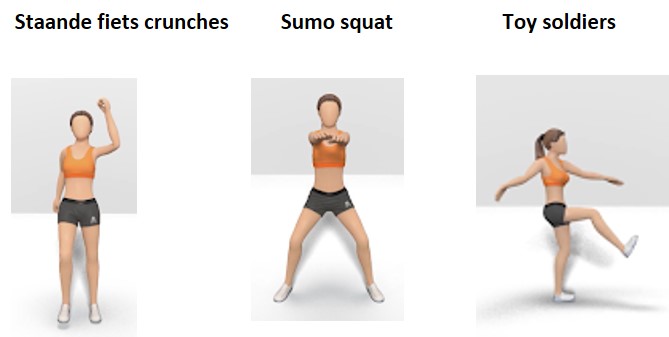
- Player 1 runs with the ball to the white pilon, player 2 runs without the ball to the white pilon.
- Player 2 rounds off on goal (with backhand).
- Player 1 runs around the pilon where player 2 started and runs to the center of the circle.
- As soon as player 1 has played the ball to player 2, player 3 may start. Player 3 plays the ball to player 4.
- Player 4 runs around the white pilon and plays the ball (with backhand) to player 1 who has run into the circle.
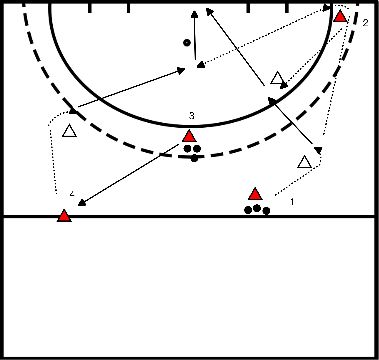
- Goal: to show the player when it is best to pass and when it is best to push.
- In case of a long pass you pass, in case of a short pass you push.
- Player 1 passes (long pass) the ball to player 2
- Player 2 pushes (short pass) the ball to player 3.
- Player 3 passes (long pass) the ball to player 4.
- Player 4 pushes (short pass) the ball to player 5.
- Player 5 passes (long pass) the ball to player 6.
- Player 6 pushes (short pass) the ball to player 7.
- Player 7 runs along the red pilons to the back line and passes (long pass) the ball to player 8, who has entered the circle.
- When explaining the exercise, you can let the player fill in whether it's a long or short pass and what kind of stroke you use, this way they will actively think about it and will apply it earlier in the game.
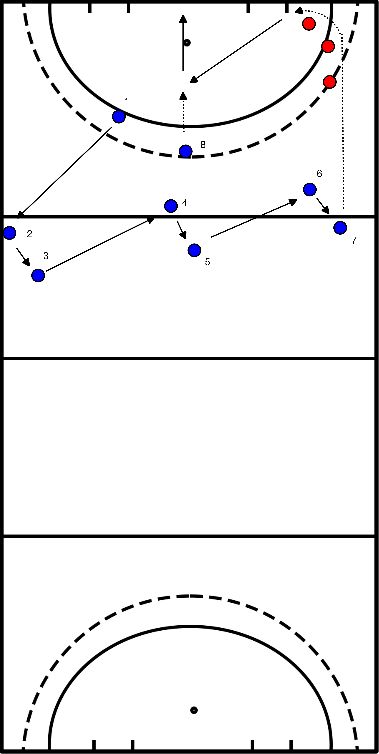
- Player 1 adapts player 2 in the loop.
- Player 2 passes the 3 pilons. On the 4th pilon, the player passes on the left and player 3 passes in the loop.
- Player 3 accompanies the ball and passes it to player 2, who has moved on to the header circle.
- Player 2 completes the round with the backhand on goal.
- Make sure player 2 at the last pilon holds the ball on the forehand and passes.
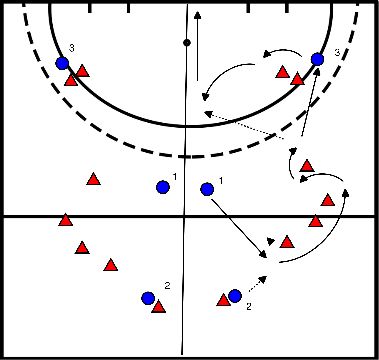
- Player 1 passes the ball to player 3 who has been caught.
- Player 3 spins the ball even further around the pilons and passes the ball to the red pilon to which player 2 has been caught.
- Player 1 has walked in to the head of the circle, player 1 gets the ball from player 2 and finishes at goal.
